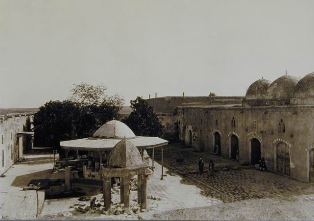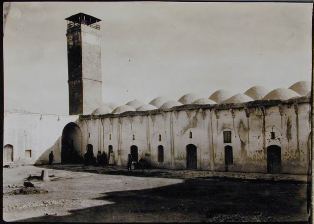An excerpt from the Safar-nama of Nasir Khusraw:
“Six Leagues farther on was Ma‘arrat al-Nu‘man, which is quite populous. It has a stone wall. Beside the city gate I saw a cylindrical column of stone, which had something written on it in a script that was not Arabic. I aksed someone what it was, and he said it was a talisman to keep scorpions from coming into town. Even if a scorpion were brought in from outside and turned loose, it would run away and not stay in the town. I estimated that column to be about ten ells high. I found the markets to be flourshing, and the Friday mosque built on a rise in the middle of town so that from whatever place one wants to go up to the mosque, one has to ascend thirteen steps. Their whole agriculture consists of wheat, which is plentiful. Figs, olives, pistachios, almonds, and grapes also abound. The city water comes from both rain and walls.
Abu'l Ala of Ma‘arra
In the town was a man named Abu’l-Ala Ma‘arra. Although blind, he was the head of the city and very wealthy, with many slaves and servants. Everyone, in the city in fact, was like a slave to him, but he himself had chosen the ascetic life. He wore coarse garments and stayed at home. He allotted himself half a maund of barley bread, and would content himself with only one loaf throughout the entire day and night. Besides that, he ate nothing. I heard it said that the door to his house was always open and that his agents and deputies did all the work of the city, except for the overall supervision, which he saw to himself. He denied his wealth to no one, although he himself was constantly fasting and vigilant at night, taking no part in the affairs of the world. This man has attained such a rank in poetry and literature that all the learned of Syria, the Maghreb, and Iraq confess that in this age there is no one of comparable sature.
He has composed a book called al-Fusul wa-ghayat, in which he speaks in engimatic parables. Although eloquent and amazing, the book can be understood only by a very few and by those who have read it with him. He has even been accused of trying to rival the Koran. There are always more than two hundred persons from all over gathered about him reading literature and poetry. I have heard that he himself has composed more than a hundred thousand lines of poetry. Someone once asked him why, since God had given him all this wealth and property, he gave it away to the people and hardly ate anything himself. His answer was, “I own nothing more than what I eat.” When I passed through that place, he was still alive.”
Source: Thackston, W. Wheeler McIntosh, ed. tr., Nasir-i Khusraw’s Book of Travels (Costa Mesa, CA: Mazda Publishers, 2010), 14–15.
Ma'arrat al-Nu‘man is a city situated about 70 km to the south of Aleppo (Halab), on the Eastern fringe of a massif rich in archaeological remains. If one accepts the identification of Ma‘arrat al-Nu‘man with Ara, the existence of a human settlement on the site of the present town, very near to Tell Mannas, dates back to the first millenium BCE. The name Arra appears as one of the Greco-Roman cities of the Antonine itinerary (a register of stations along the roads of Roman Empire) and is mentioned in Assyrian texts among the conquests of the empire in 738 BCE. The second name al-Nu‘man is said to have been in attribution to the name of a companion of Prophet Muhammad.
In the vicinity of Ma'arrat al-Nu‘man there is no running water. The inhabitants have to collect rain water in cisterns. The water cisterns, together with the wells, have allowed a rich agriculture without irrigation since antiquity. According to Ibn Jubayr, a geographer, traveller and poet from al-Andalus (d. 614 AH / 1217 CE), it used to take two days to cross the area covered by gardens which stretched all around the town. In the Ayyubid period, this land was one of the most fertile and rich in the world. To the west of Ma‘arrat Al-Nu‘man, since classical times, there has been cultivation of olive trees and vineyards; near the town, in the gardens, grow pistachio and almond trees, while to the east, stretch fields of cereals (corn and barley). The region produces three essential commodities: corn, olives and raisins for export. Since its establishment, the city has been an important crossroads and active economic centre.
Ma'arrat al-Nu‘man from Early to Medieval Muslim Period: After the Arab conquest, Ma'arrat al-Nu‘man came to be designated as a town in jurisdiction of the jund (military establishment) of Homs. During the time of the Abbasid Caliph Harun al-Rashid (r. 170-193 AH / 786-809 CE), it was incorporated in the jund of Qinnasrin of Aleppo. According to the historians al-Baladhuri (d. 279 AH / 892 CE) and Yaqubi (d. 278 AH / 891 CE), and noted again by Ibn Battuta (703-799 AH / 1304-1377 CE) and Khalil al-Zahiri (Zubda) (813-873 AH / 1410-1468 CE) the town was at one time called Dhat al-Qusur “the town of palaces”. It served as a centre of exchange between the mountain and the plain, and as a collection centre, especially for agricultural products. In 340 AH / 951 CE it was already a prosperous town. In the middle ages, Ma'arrat al-Nu‘man was the first objective to be attained by any adversary, coming from the North-West, North or North-East.
Ma'arrat al-Nu‘man during Ottoman and modern period: During Ottoman times, the town had its own fiscal regulation which emphasise its economic importance. Taxes were paid on merchandise in transit and animals, and the produce was transported from the villages to the town. Ma'arrat al-Nu‘man preserved its role as commercial centre, especially for the trade of crafts.
Demographically, Ma'arrat al-Nu'man saw growth in the 20th century, as did the rest of Syria. The town continues to preserve traces of antiquity. The Great Mosque of Ma'arrat al-Nu'man is built on the site of an ancient temple and a church, converted to a mosque after the arrival of Muslims. Extensive re-use of ancient remains bears witness to the antiquity of the sanctuary. The square minaret of the Great Mosque is among the unique monuments of Syria, designed by the architect Qahir b. Ali b. Qanit al-Sarmani, who in 595 AH / 1199 CE also built the town’s Shafi‘i madrasa.
Some souks (covered marketplaces) of very ancient origin surround the Great Mosque. In the city there are still some remains of covered, vaulted streets like Jerusalem. There was, in the period of the Crusades, in the southern part of the town, a church of St. Andrew of which some foundations still survive. A Monophysite monastery is also believed to have existed there, the location of which is uncertain. There are in the town and its environs a large number of sculpted arch-stones in basalt (volcanic rock) re-used from ancient Christian tombs. An Ottoman khan (caravansary) has also survived to the south of the Great Mosque, in the eastern part of the town.
There are many places of pilgrimage or oratories in Ma'arrat al-Nu‘man, including the Maqam Nabi Allah Yusha‘ b. Nun, often cited as a jami‘ or mashhad, situated outside the south walls of the town. The tomb of Yusha’ (the biblical Joshua) is probably on the site of an ancient pre-Islamic sanctuary. The modern mausoleum of the illustrious blind poet, Abu’l-‘Ala al-Ma‘arri, for whom the town is famous, is also situated in the town.
Citation
N. Elisséeff "Ma'arrat al-Nu‘man." Encyclopaedia of Islam, Second Edition. Brill Online
http://referenceworks.brillonline.com/entries/encyclopaedia-of-islam-2/maarrat-al-numan-COM_0598 [accessed June 2013]
Alice C. Hunsberger, Nasir Khusraw, the Ruby of Badakhshan. (I. B. Tauris, London, 2000).
K. M. Setton and M. W. Baldwin, eds., History of the Crusades, (Philadelphia, vol. i, 1955, index; vol. ii, 1962, p. 700), 705-775
More images of the Great Mosque of Ma'rrat al-Nu‘man
http://www.archnet.org/media_contents/34823 [accessed February 2014]

